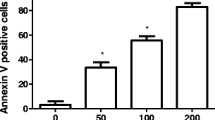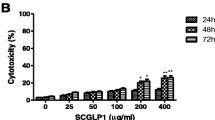Abstract
In the present study, we isolated and characterized a water-soluble polysaccharide (GIP1) from the roots of Glycyrrhiza inflata. The goal of this study was to investigate the anti-tumor effect of GIP1 on the human oral cancer SCC-25 cell line and to explore the possible mechanism. Our experimental result showed that GIP1 (50, 100, and 200 μg/mL) specifically decreased cell viability of SCC-25 cells in a concentration-dependent manner via the induction of apoptosis. Furthermore, Western blot analysis showed that exposure of SCC-25 cells to GIP1 led to down-regulation of anti-apoptotic protein Bcl-2 and up-regulation of pro-apoptotic protein Bax, thus causing a loss of mitochondrial membrane potential and the release of cytochrome c to the cytosol. Moreover, we observed activation of the initiator caspaes-9, and the effector caspases-3, but not caspase-8. Concomitantly, GIP1-induced apoptosis can be blocked by caspase-3- or caspase-9-specific inhibitor, but not caspase-8 inhibitor. As well, the cleaved poly (ADP-ribose) polymerase, as a caspae-3 substrate, occurred in SCC-25 cells following GIP1 treatment at three concentrations. Collectively, our results showed that the GIP1 induced apoptosis in SCC-25 cells involving a caspase-dependent mitochondrial signaling pathway.




Similar content being viewed by others
References
Chan CK, Goh BH, Kamarudin MN, Kadir HA. Aqueous fraction of Nephelium ramboutan-ake rind induces mitochondrial-mediated apoptosis in HT-29 human colorectal adenocarcinoma cells. Molecules. 2012;17:6633–57.
Li CL, Wu HZ, Huang YP, Yang YF, Liu YW, Liu JW. 6-O-Angeloylenolin induces apoptosis through a mitochondrial/caspase and NF-kB pathway in human leukemia HL60 cells. Biomed Pharmacother. 2008;62:401–9.
Lin T, Yin X, Cai Q, Fan X, Xu K, Huang L, et al. 13-Methyltetradecanoic acid induces mitochondrial-mediated apoptosis in human bladder cancer cells. Urol Oncol. 2012;30:339–45.
Lee KH. Anticancer drug design based on plant-derived natural products. J Biomed Sci. 1999;6:236–50.
Craig WJ. Phytochemicals: guardians of our health. J Am Diet Assoc. 1997;97:S199–204.
Craig WJ. Health-promoting properties of common herbs. Am J Clin Nutr. 1999;70:S491–9.
Banerjee S, Panda CK, Das S. Clove (Syzygium aromaticum L.), a potential chemopreventive agent for lung cancer. Carcinogenesis. 2006;27:1645–54.
Deorukhkar A, Krishnan S, Sethi G, Aggarwal BB. Back to basics: how natural products can provide the basis for new therapeutics. Expert Opin Investig Drugs. 2007;16:1753–73.
Asl MN, Hosseinzadeh H. Review of pharmacological effects of Glycyrrhiza sp. and its bioactive compounds. Phytother Res. 2008;22:709–24.
Guo X, Rukiya M, Mourboul A, Sheng L, Abulizi A. Anti-cancer activity of flavonoids from Xinjiang Glycyrrhiza inflata Licorice on proliferation, cytotoxicity and apoptosis in cervical carcinoma cells. J Med Plant Res. 2013;7:173–8.
Shibata S. A drug over the millennia: pharmacognosy, chemistry, and pharmacology of licorice. Yakugaku Zasshi. 2000;120:849–62.
Cong YY, Kasimu R, Dai H, Abulizi P, Sheng P, Gao XM, et al. A neutral polysaccharide from Glycyrrhiza inflata. Chem Nat Compd. 2009;45:11–3.
Staub AM. Removal of protein-Sevag method. Methods Carbohydr Chem. 1965;5:5–6.
Dubois M, Gilles KA, Hamilton JK, Rebers PA, Smith F. Colorimetric method for determination of sugars and related substances. Anal Chem. 1956;28:350–6.
Bradford MM. A rapid and sensitive method for the quantitation of microgram quantities of protein utilizing the principle of protein-dye binding. Anal Biochem. 1976;72:248–54.
Blumenkrantz N, Asboe-Hansen G. New method for quantitative determination of uronic acids. Anal Biochem. 1973;54:484–9.
Sun YX, Liu JH, Yue LL, Zhang CJ, Yu HT, Wu Q, et al. One proteoglycan from the fruiting bodies of Chroogomphis rutilus (Schaeff.: Fr.) O.K. Miller: purification and structural features. Carbohydr Polym. 2011;86:1381–4.
Li X, Zhao X, Wang H, Han J, Liu L. A polysaccharide from the fruiting bodies of Agaricus blazei Murill induces caspase-dependent apoptosis in human leukemia HL-60 cells. Tumour Biol. 2014;35:8963–8.
Hsu YL, Chia CC, Chen PJ, Huang SE, Huang SC, Kuo PL. Shallot and licorice constituent isoliquiritigenin arrests cell cycle progression and induces apoptosis through the induction of ATM/p53 and initiation of the mitochondrial system in human cervical carcinoma HeLa cells. Mol Nutr Food Res. 2009;53:826–35.
Keshavan P, Schwemberger SJ, Smith DL, Babcock GF, Zucker SD. Unconjugated bilirubin induces apoptosis in colon cancer cells by triggering mitochondrial depolarization. Int J Cancer. 2004;112:433–45.
Li YY, Zhang Z, Wang ZH, Wang HW, Zhang L, Zhu L. rBTI induces apoptosis in human solid tumor cell lines by loss in mitochondrial transmembrane potential and caspase activation. Toxicol Lett. 2009;189:166–75.
Yang SF, Chen MK, Hsieh YS, Yang JS, Zavras AI, Hsieh YH, et al. Antimetastatic effects of Terminalia catappa L. on oral cancer via a down-regulation of metastasis-associated proteases. Food Chem Toxicol. 2010;48:1052–8.
Sun Z, Huang K, Fu X, Zhou Z, Cui Y, Li H. A chemically sulfated polysaccharide derived from Ganoderma lucidum induces mitochondrial-mediated apoptosis in human osteosarcoma MG63 cells. Tumour Biol. 2014;35:9919–26.
Zeng G, Shen H, Yang Y, Cai X, Xun W. Licochalcone A as a potent antitumor agent suppresses growth of human oral cancer SCC-25 cells in vitro via caspase-3 dependent pathways. Tumour Biol. 2014;35:6549–55.
Wang X, Chen Y, Wang J, Liu Z, Zhao S. Antitumor activity of a sulfated polysaccharide from Enteromorpha intestinalis targeted against hepatoma through mitochondrial pathway. Tumour Biol. 2014;35:1641–7.
Conflicts of interest
None
Author information
Authors and Affiliations
Corresponding authors
Additional information
Huan Shen, Guang Zeng and Bin Sun contributed equally to this work.
Rights and permissions
About this article
Cite this article
Shen, H., Zeng, G., Sun, B. et al. A polysaccharide from Glycyrrhiza inflata Licorice inhibits proliferation of human oral cancer cells by inducing apoptosis via mitochondrial pathway. Tumor Biol. 36, 4825–4831 (2015). https://doi.org/10.1007/s13277-015-3135-6
Received:
Accepted:
Published:
Issue Date:
DOI: https://doi.org/10.1007/s13277-015-3135-6




